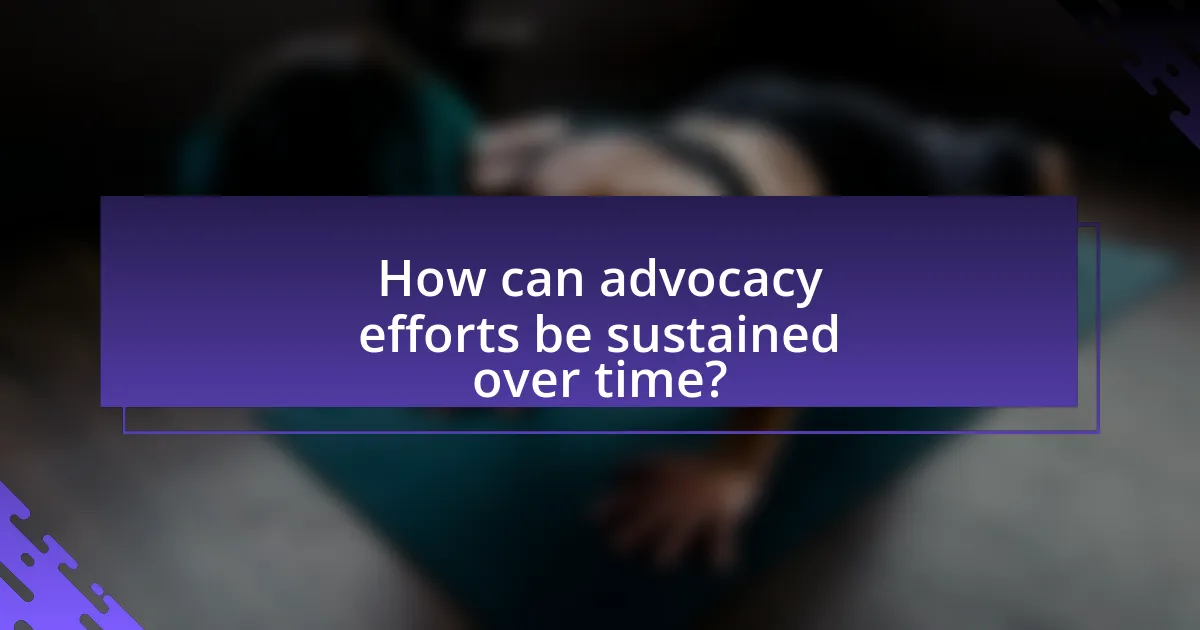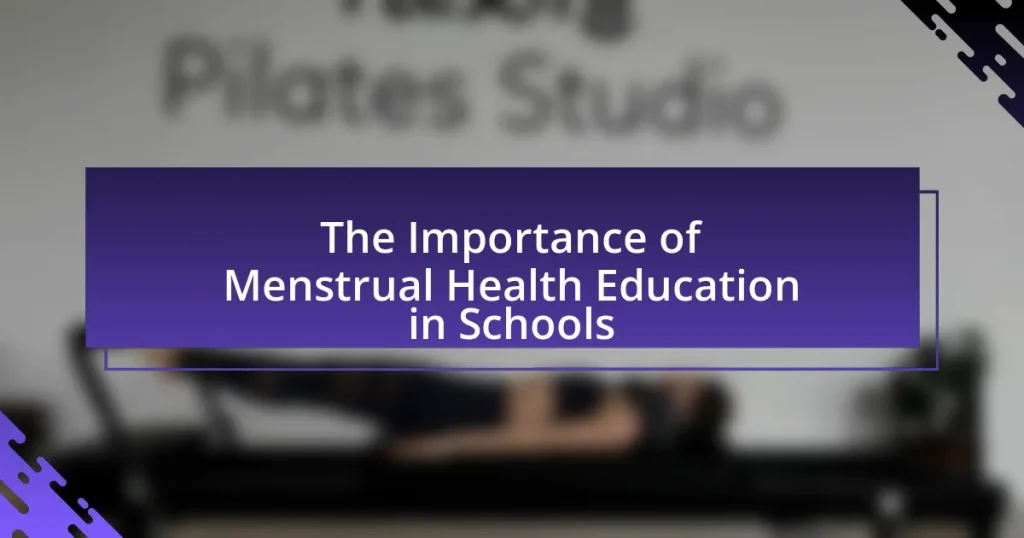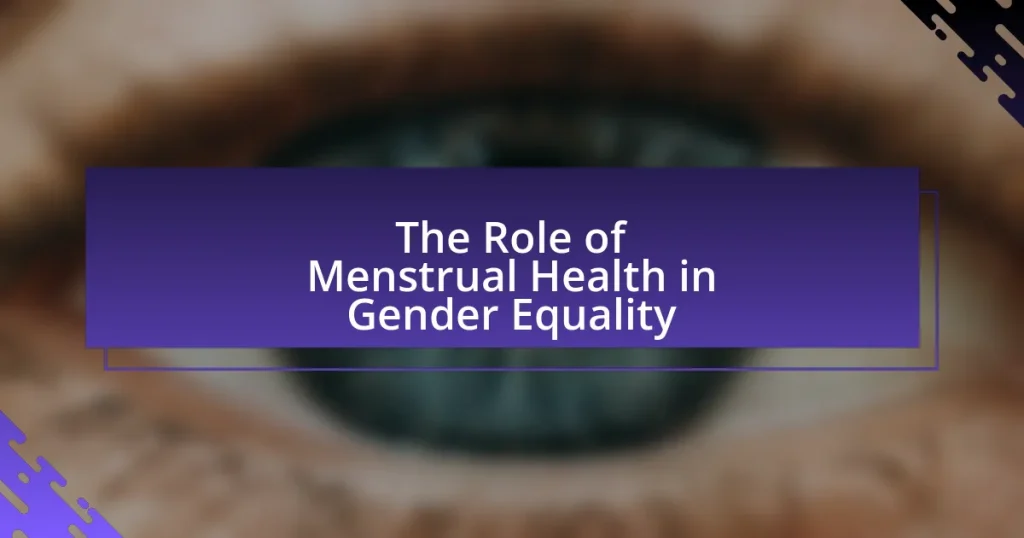Advocating for menstrual health in your community involves promoting awareness, access, and education regarding menstrual hygiene and health issues. The article outlines the importance of menstrual health advocacy, highlighting its role in reducing stigma, improving access to menstrual products, and enhancing educational and economic opportunities for individuals who menstruate. It discusses the social implications of menstrual health awareness, the key stakeholders involved, and the challenges advocates face, including cultural stigmas and resource accessibility. Additionally, it provides strategies for effective advocacy, the role of schools and healthcare providers, and methods to sustain engagement and measure impact, ultimately emphasizing the need for community involvement in promoting menstrual health.

What does it mean to advocate for menstrual health in your community?
Advocating for menstrual health in your community means actively promoting awareness, access, and education regarding menstrual hygiene and health issues. This involves organizing campaigns to eliminate stigma, ensuring the availability of menstrual products, and providing information about menstrual health management. For instance, studies show that lack of access to menstrual products can lead to absenteeism in schools, with 1 in 10 girls in Africa missing school during their periods due to inadequate resources. Therefore, advocating for menstrual health not only addresses individual needs but also contributes to broader social and educational outcomes.
Why is menstrual health advocacy important?
Menstrual health advocacy is important because it promotes awareness and understanding of menstrual health issues, which are often stigmatized and overlooked. Advocacy efforts lead to improved access to menstrual products, education, and healthcare services, ultimately supporting the physical and mental well-being of individuals who menstruate. For instance, a study by the World Bank found that lack of access to menstrual hygiene products can lead to school absenteeism, with girls missing up to 20% of school days due to menstruation. This highlights the critical need for advocacy to ensure that menstrual health is recognized as a fundamental aspect of public health and gender equality.
What are the social implications of menstrual health awareness?
Menstrual health awareness has significant social implications, including the reduction of stigma surrounding menstruation and the promotion of gender equality. Increased awareness leads to open discussions about menstrual health, which can dismantle long-standing taboos and encourage supportive environments for individuals who menstruate. For instance, a study published in the journal “BMC Women’s Health” found that communities with higher menstrual health education reported lower levels of stigma and improved access to menstrual products. Furthermore, menstrual health awareness initiatives can empower women and girls by ensuring they have the knowledge and resources to manage their health, thereby enhancing their participation in education and the workforce. This empowerment contributes to broader societal changes, such as improved economic stability and health outcomes for future generations.
How does menstrual health impact overall community health?
Menstrual health significantly impacts overall community health by influencing women’s physical, mental, and social well-being. When menstrual health is prioritized, it leads to improved educational and economic opportunities for women, as they can attend school and work without interruption due to menstrual-related issues. Research indicates that inadequate menstrual health management can result in absenteeism, with studies showing that girls may miss up to 20% of school days due to menstruation. Furthermore, communities that support menstrual health initiatives often experience lower rates of reproductive health issues, as access to menstrual hygiene products and education reduces the risk of infections and other health complications. Thus, promoting menstrual health is essential for fostering a healthier, more equitable community.
Who are the key stakeholders in menstrual health advocacy?
Key stakeholders in menstrual health advocacy include government agencies, non-governmental organizations (NGOs), healthcare providers, educators, and community leaders. Government agencies play a crucial role by creating policies and funding programs that support menstrual health initiatives. NGOs often lead awareness campaigns and provide resources to underserved populations, while healthcare providers offer essential services and education regarding menstrual health. Educators contribute by integrating menstrual health education into school curricula, and community leaders help mobilize local support and resources. Collectively, these stakeholders work to improve access to menstrual health products and education, ultimately fostering a more informed and supportive environment for menstrual health.
What roles do schools play in promoting menstrual health?
Schools play a crucial role in promoting menstrual health by providing education, resources, and a supportive environment for students. They implement comprehensive menstrual health education programs that inform students about the biological aspects of menstruation, hygiene practices, and the importance of menstrual health management. Research indicates that schools that incorporate menstrual health education can significantly reduce stigma and misinformation, leading to improved health outcomes for students. For instance, a study published in the Journal of Adolescent Health found that comprehensive education on menstrual health can enhance knowledge and self-efficacy among adolescents, ultimately fostering a more positive attitude towards menstruation. Additionally, schools can facilitate access to menstrual products and create a supportive atmosphere where students feel comfortable discussing their needs and concerns related to menstruation.
How can healthcare providers contribute to menstrual health advocacy?
Healthcare providers can contribute to menstrual health advocacy by educating patients and the community about menstrual health issues and promoting access to necessary resources. They can offer accurate information on menstrual hygiene management, address misconceptions, and provide guidance on menstrual disorders. Research indicates that healthcare professionals play a crucial role in reducing stigma and improving health outcomes; for instance, a study published in the Journal of Women’s Health found that education from healthcare providers significantly increased awareness and understanding of menstrual health among adolescents. By actively participating in community outreach programs and collaborating with organizations focused on menstrual health, healthcare providers can further enhance advocacy efforts and ensure that menstrual health is recognized as a vital aspect of overall health.
What challenges do advocates face in promoting menstrual health?
Advocates face significant challenges in promoting menstrual health, primarily due to cultural stigma and misinformation surrounding menstruation. Cultural taboos often lead to silence and shame, hindering open discussions about menstrual health. For instance, in many societies, menstruation is considered a taboo subject, which can prevent individuals from seeking necessary information and resources. Additionally, a lack of access to menstrual products and education exacerbates the issue, as many individuals cannot afford or find adequate supplies. According to a study by the World Bank, 500 million women and girls globally lack access to menstrual products and education, highlighting the scale of the challenge. Furthermore, advocates often encounter resistance from policymakers who may not prioritize menstrual health in public health agendas, limiting funding and support for initiatives aimed at improving menstrual health awareness and resources.
How do cultural stigmas affect menstrual health discussions?
Cultural stigmas significantly hinder menstrual health discussions by creating an environment of silence and shame around menstruation. These stigmas often lead to misinformation, lack of education, and reluctance to seek help, which can exacerbate health issues related to menstruation. For instance, a study published in the journal “BMC Women’s Health” found that in many cultures, menstruation is viewed as dirty or taboo, resulting in women feeling uncomfortable discussing their menstrual health with peers or healthcare providers. This lack of open dialogue can prevent individuals from accessing necessary resources and support, ultimately impacting their overall health and well-being.
What barriers exist in accessing menstrual health resources?
Barriers in accessing menstrual health resources include stigma, lack of education, financial constraints, and inadequate infrastructure. Stigma surrounding menstruation often leads to silence and shame, preventing individuals from seeking necessary resources. A lack of education about menstrual health contributes to misinformation and reluctance to access services. Financial constraints hinder the ability to purchase menstrual products, with studies indicating that 1 in 5 girls in the U.S. have missed school due to lack of access to these products. Additionally, inadequate infrastructure, particularly in low-income areas, limits the availability of menstrual health resources, as many communities lack proper sanitation facilities and access to healthcare services.
How can individuals start advocating for menstrual health?
Individuals can start advocating for menstrual health by educating themselves and others about menstrual hygiene management and the challenges faced by those who menstruate. This can involve sharing accurate information through workshops, social media campaigns, or community events, which can raise awareness and reduce stigma. Research indicates that education on menstrual health can significantly improve knowledge and attitudes, as seen in studies conducted by the World Health Organization, which highlight the importance of informed communities in promoting health equity. By engaging in discussions, supporting policy changes, and collaborating with local organizations, individuals can effectively contribute to a broader movement for menstrual health advocacy.

What strategies can be employed for effective advocacy?
Effective advocacy for menstrual health can be achieved through strategies such as community engagement, education, coalition building, and policy advocacy. Community engagement involves actively involving local stakeholders, including individuals affected by menstrual health issues, to ensure their voices are heard and needs are addressed. Education is crucial; providing accurate information about menstrual health can dispel myths and reduce stigma, as evidenced by programs that have successfully increased awareness and understanding in various communities. Coalition building brings together diverse organizations and individuals to strengthen the advocacy effort, leveraging resources and expertise for greater impact. Policy advocacy focuses on influencing legislation and policies that support menstrual health, which has been shown to lead to improved access to menstrual products and education, as seen in countries that have implemented supportive policies.
How can community awareness be raised about menstrual health?
Community awareness about menstrual health can be raised through educational workshops and campaigns that provide accurate information. These initiatives can include school programs, community health fairs, and social media outreach, which aim to dispel myths and promote understanding of menstrual health. Research indicates that comprehensive education on menstrual health can lead to improved health outcomes and reduced stigma, as evidenced by a study published in the Journal of Adolescent Health, which found that informed communities experience better menstrual hygiene practices and increased support for individuals menstruating.
What role do social media campaigns play in advocacy?
Social media campaigns play a crucial role in advocacy by amplifying messages, mobilizing supporters, and fostering community engagement. These campaigns enable organizations and individuals to reach a broader audience quickly, facilitating the dissemination of information related to menstrual health. For instance, the #MenstrualHygieneDay campaign has successfully raised awareness and encouraged discussions around menstrual health issues globally, demonstrating the effectiveness of social media in driving advocacy efforts. Additionally, studies show that social media can increase public participation in advocacy initiatives, with platforms like Twitter and Instagram serving as vital tools for grassroots movements.
How can workshops and seminars educate the community?
Workshops and seminars can educate the community by providing targeted information and resources about menstrual health. These events facilitate discussions, share expert knowledge, and promote awareness of menstrual health issues, which are often stigmatized or misunderstood. For instance, a study by the World Health Organization indicates that educational programs significantly improve knowledge and attitudes towards menstrual health, leading to better health outcomes. By engaging participants through interactive activities and expert-led sessions, workshops and seminars empower individuals with the knowledge necessary to advocate for their own health and the health of others in their community.
What partnerships can enhance menstrual health advocacy efforts?
Collaborations with healthcare organizations, educational institutions, and non-profit groups can significantly enhance menstrual health advocacy efforts. Healthcare organizations can provide medical expertise and resources, ensuring accurate information dissemination and access to necessary health services. Educational institutions can integrate menstrual health education into their curricula, fostering awareness and reducing stigma among students. Non-profit groups often have established networks and community outreach capabilities, which can amplify advocacy messages and mobilize community support. For instance, partnerships with organizations like Planned Parenthood have been shown to improve access to menstrual health resources and education, thereby increasing community engagement and awareness.
How can local businesses support menstrual health initiatives?
Local businesses can support menstrual health initiatives by providing access to menstrual products and educational resources. For instance, businesses can partner with organizations that distribute menstrual hygiene products to underserved communities, ensuring that individuals have the necessary supplies. Additionally, local businesses can host workshops or informational sessions on menstrual health, promoting awareness and reducing stigma. Research indicates that access to menstrual products can significantly improve school attendance and overall well-being, highlighting the importance of local business involvement in these initiatives.
What organizations can be allies in advocacy efforts?
Organizations that can be allies in advocacy efforts for menstrual health include Planned Parenthood, the Menstrual Health Hub, and the World Health Organization. Planned Parenthood provides reproductive health services and education, which can support menstrual health initiatives. The Menstrual Health Hub focuses specifically on menstrual health and hygiene, offering resources and networking opportunities for advocates. The World Health Organization promotes global health standards, including menstrual health, and can lend credibility and support to advocacy efforts. These organizations have established networks and resources that can enhance the effectiveness of advocacy campaigns.
What resources are available for menstrual health advocacy?
Resources available for menstrual health advocacy include organizations, educational materials, and online platforms. Notable organizations such as the Menstrual Health Hub and Period.org provide comprehensive resources, including toolkits, research, and advocacy guides. Educational materials from sources like the World Health Organization offer insights into menstrual health and hygiene management. Additionally, online platforms like social media and blogs facilitate community engagement and awareness campaigns, allowing advocates to share information and mobilize support effectively. These resources collectively empower individuals and groups to promote menstrual health awareness and drive policy changes.
Where can educational materials be found?
Educational materials can be found through various sources, including online platforms, educational institutions, and community organizations. Websites such as the World Health Organization and Planned Parenthood provide comprehensive resources on menstrual health. Additionally, local schools and universities often have educational programs and materials available for community outreach. Nonprofit organizations focused on women’s health also distribute pamphlets, guides, and workshops that educate the public on menstrual health advocacy.
What funding opportunities exist for advocacy projects?
Funding opportunities for advocacy projects include grants from government agencies, private foundations, and nonprofit organizations. For instance, the U.S. Department of Health and Human Services offers funding through programs aimed at improving public health, which can support menstrual health initiatives. Additionally, organizations like the Bill & Melinda Gates Foundation provide grants specifically for health-related advocacy projects, including those focused on women’s health. These funding sources are essential for implementing community-based programs that promote menstrual health awareness and education.
What are some best practices for advocating for menstrual health?
Best practices for advocating for menstrual health include raising awareness through education, promoting access to menstrual products, and engaging in policy advocacy. Education initiatives can inform communities about menstrual health, reducing stigma and misinformation; for instance, studies show that comprehensive menstrual education can improve knowledge and attitudes towards menstruation. Ensuring access to menstrual products is crucial, as research indicates that lack of access can lead to absenteeism in schools and workplaces. Engaging in policy advocacy involves collaborating with local governments to implement supportive policies, such as providing free menstrual products in public spaces, which has been shown to enhance menstrual health equity.

How can advocacy efforts be sustained over time?
Advocacy efforts can be sustained over time by building strong coalitions, maintaining consistent communication, and securing ongoing funding. Strong coalitions create a network of support that amplifies the advocacy message and ensures diverse perspectives are included. Consistent communication keeps stakeholders engaged and informed, fostering a sense of community and shared purpose. Securing ongoing funding is crucial, as it provides the necessary resources to continue advocacy activities, such as educational campaigns and community outreach programs. Research indicates that organizations with stable funding sources are more likely to achieve long-term advocacy goals, as demonstrated by the success of various health initiatives that maintained funding over multiple years.
What methods can be used to measure the impact of advocacy?
Methods to measure the impact of advocacy include surveys, focus groups, and policy analysis. Surveys can quantify changes in public awareness or attitudes regarding menstrual health, while focus groups provide qualitative insights into community perceptions and experiences. Policy analysis evaluates the effectiveness of advocacy efforts by examining changes in legislation or funding related to menstrual health. For instance, a study by the Guttmacher Institute found that advocacy efforts led to increased funding for menstrual health programs in several states, demonstrating a measurable impact on policy outcomes.
How can feedback from the community inform future efforts?
Feedback from the community can inform future efforts by providing insights into the specific needs and preferences of individuals regarding menstrual health initiatives. Engaging with community members through surveys, focus groups, or public forums allows advocates to gather data on barriers to access, cultural perceptions, and desired resources. For instance, a study published in the Journal of Adolescent Health found that community feedback significantly improved the effectiveness of health programs by aligning them with the actual experiences and expectations of participants. This evidence demonstrates that incorporating community input leads to more relevant and impactful menstrual health advocacy efforts.
What strategies can ensure ongoing engagement and support?
To ensure ongoing engagement and support for menstrual health advocacy in the community, implementing regular educational workshops and creating a supportive online platform are effective strategies. Educational workshops foster awareness and provide essential information about menstrual health, which can lead to increased community involvement. For instance, studies show that communities with regular health education programs see a 30% increase in participation in health-related initiatives. Additionally, an online platform allows for continuous dialogue, resource sharing, and support among community members, enhancing the sense of belonging and commitment to the cause. This dual approach not only informs but also empowers individuals, ensuring sustained engagement and support for menstrual health initiatives.
What are the next steps for individuals interested in menstrual health advocacy?
Individuals interested in menstrual health advocacy should start by educating themselves on menstrual health issues and the barriers faced by various communities. This foundational knowledge enables advocates to effectively communicate the importance of menstrual health and its impact on overall well-being. Engaging with local organizations that focus on women’s health can provide resources and support, as well as opportunities for collaboration.
Additionally, individuals can participate in community discussions and forums to raise awareness and share information about menstrual health. Organizing or joining campaigns that promote access to menstrual products and education can further amplify their advocacy efforts. Research indicates that 1 in 5 girls in the U.S. have missed school due to a lack of menstrual products, highlighting the urgent need for advocacy in this area. By taking these steps, individuals can contribute to meaningful change in menstrual health awareness and access within their communities.



